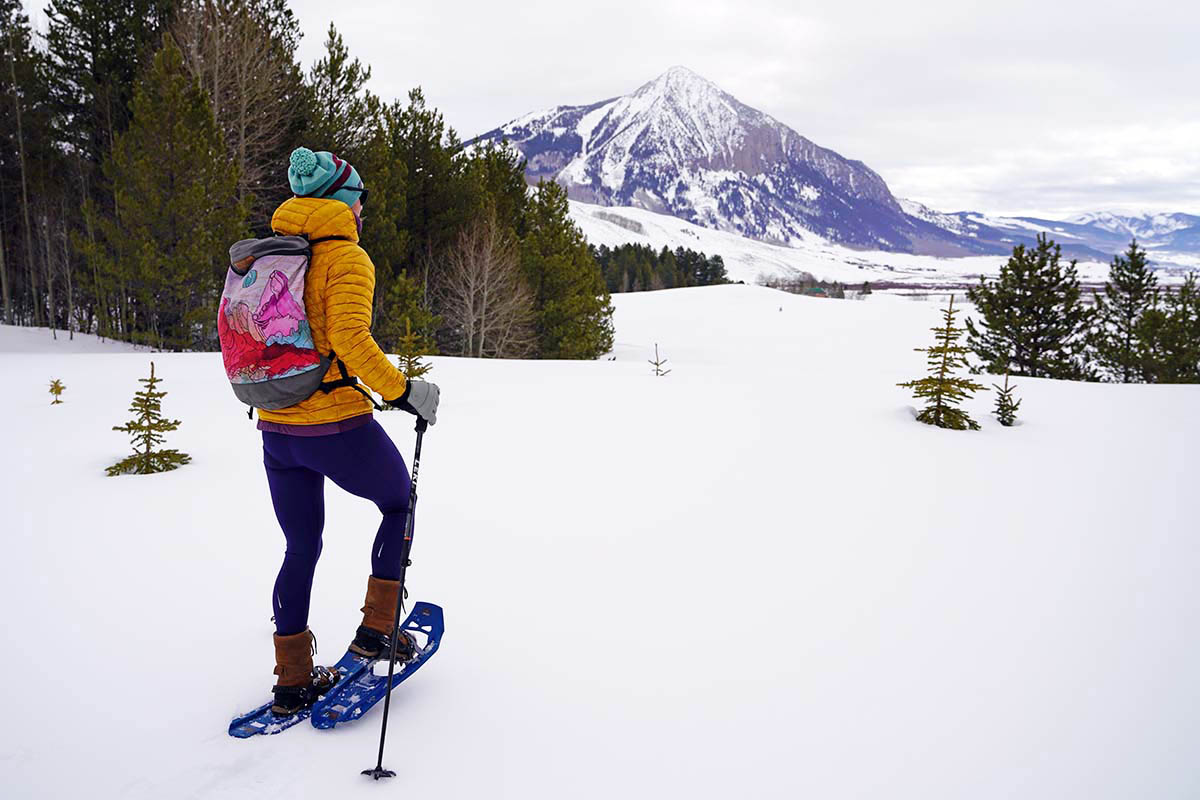
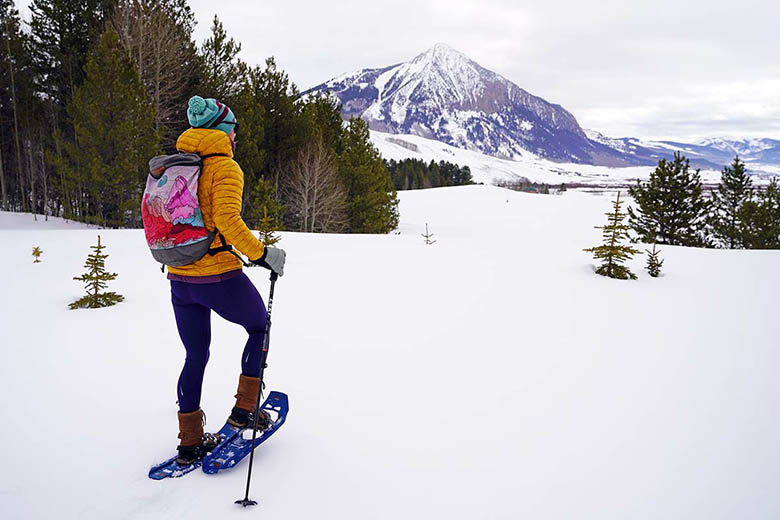
Switchback Travel


Switchback Travel
Price: $140
Length: 22 in. (6-in. tails optional)
Weight per pair: 3 lbs. 9 oz.
What we like: Great traction and versatility in a range of snow conditions for under $150.
What we don’t: Fairly basic plastic decking can be noisy on packed snow and lacks flexibility.
See the MSR Evo Trail
MSR is well-regarded in the world of snowshoes, and their budget-friendly Evo Trail remains a favorite year after year. At this price point, you get a simple molded plastic decking, but it’s nevertheless a great value with excellent traction, a quality build, and good all-around performance on all but the most challenging terrain. Taken together, we consider the Evo Trail everything most snowshoers need and nothing they don’t. Below we break down our experiences with the Evo Trail. To see how it stacks up to the competition, see our article on the best snowshoes.
Floatation is often the most crucial consideration for snowshoers, and we’re happy to report that the MSR Evo Trail is a good overall performer. With a 22-inch length (more on that below), the snowshoes are fully capable in less-extreme conditions, including packed snow and light to moderate powder. If you do decide to venture into deeper snow, MSR sells tails that add 6 inches of length (sold separately for $50). The tails are an added cost, but they can provide a nice dose of versatility and are easy to throw in your pack for more adventurous outings. If you need even more flotation, choosing a snowshoe with a longer length is the way to go. For example, MSR makes the Lightning Ascent in three sizes up to 35 inches with tails (and importantly, longer models can also accommodate heavier loads).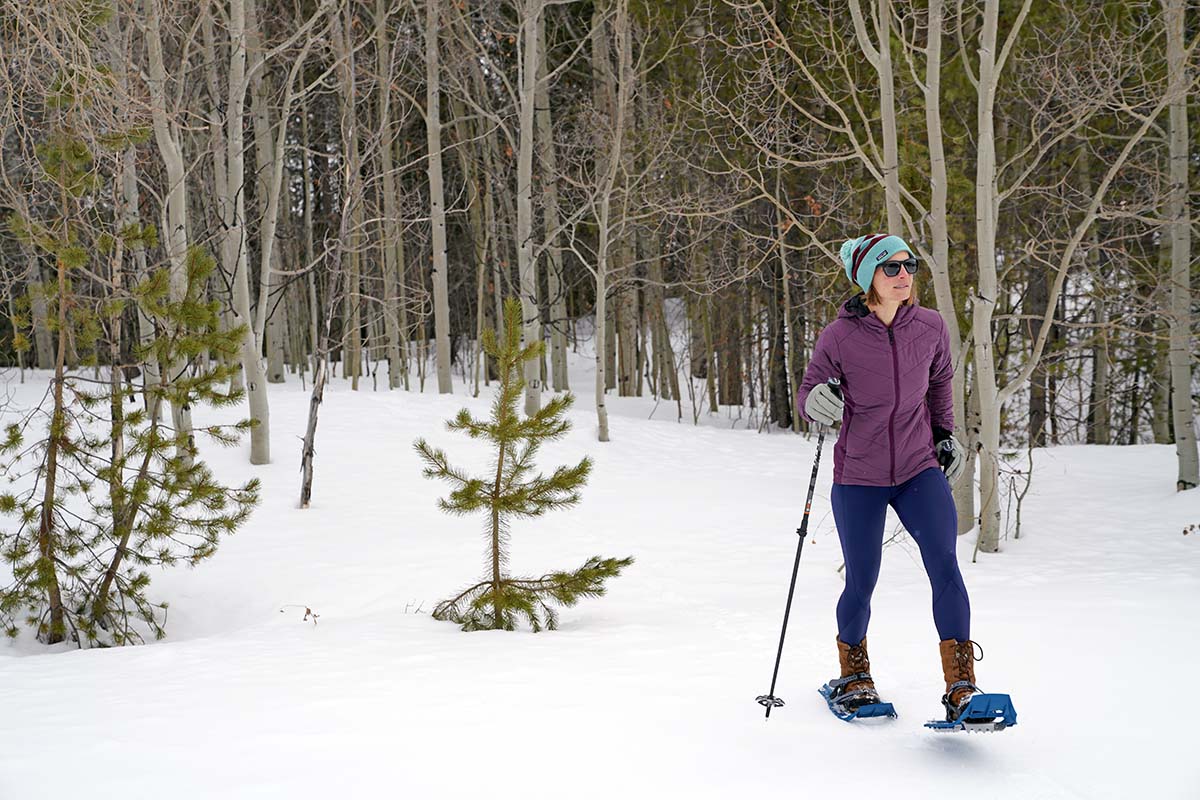
As far as decking goes, snowshoes generally fall into one of two categories: aluminum-framed models with flexible nylon decking or frameless, solid options with a plastic or composite deck. The MSR Evo Trail is part of the latter category, with a molded piece of polypropylene plastic (MSR dubs this their “UniBody” deck) to keep things simple and cheap. Compared to nylon decking, the MSR’s plastic is louder on hardpack and doesn’t have the flexibility of some of the higher-end composites, but it certainly gets the job done over groomed trails and rolling terrain (at a fraction of the cost). And we did have one instance with the plastic cracking when someone accidentally stepped on the front of our shoes, but this was a rare occurrence and shouldn’t be a major concern for most users (more in “Build Quality and Durability” below).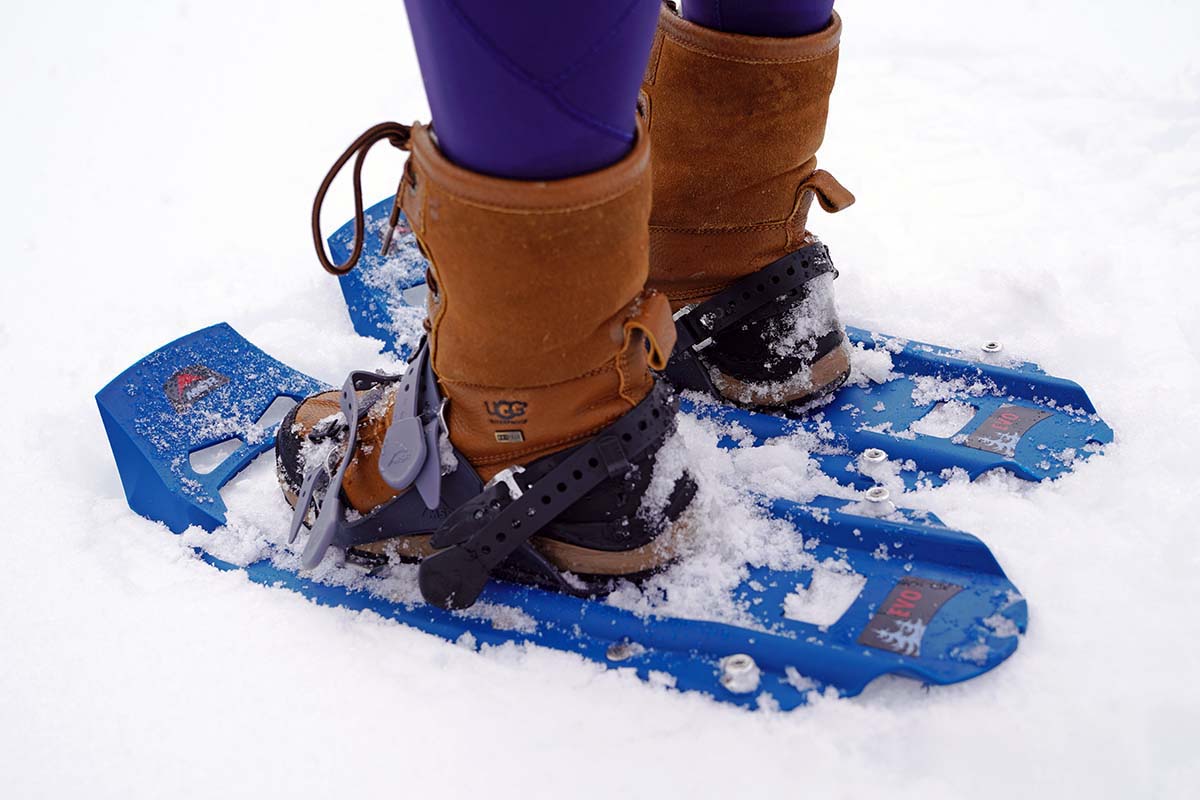
Traction was surprisingly good considering the MSR Evo Trail’s affordable price. A handful of budget models use cheaper and flimsier aluminum crampons, but MSR chose more hardwearing steel, with crampon rails running both ways on the shoe (two steel bars down the length of the shoe and one running across the center under the ball of the foot). In practice, the crampons have a healthy amount of bite: the center crampon is deep and grippy, and the teeth down the sides dig nicely and reliably into snow and ice. 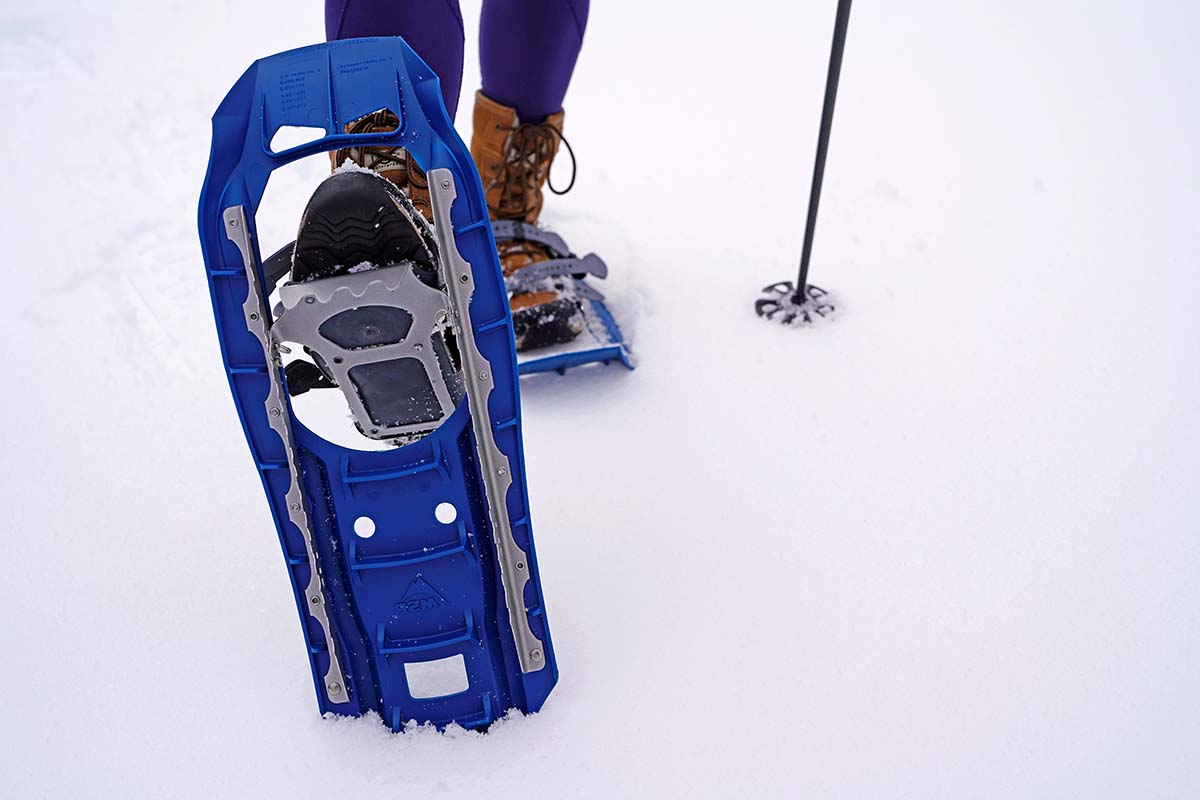
Stacked up to the competition, the MSR's versatile and sturdy traction gets the clear edge. Many alternatives feature simple crampons underfoot and lack the side bars (like the Tubbs Xplore), while other entry-level options utilize less-durable aluminum. And in the case of the Crescent Moon EVA and some others, you only get steel spikes, which are much less grippy than the rail system on the Evo Trail. It's worth noting that a new competitor for this year is the Atlas Helium-Trail, which has a very similar crampon set-up to the MSR and also uses steel. But given the unproven nature of the Helium, it's hard to put it on the same level as the long-standing Evo Trail.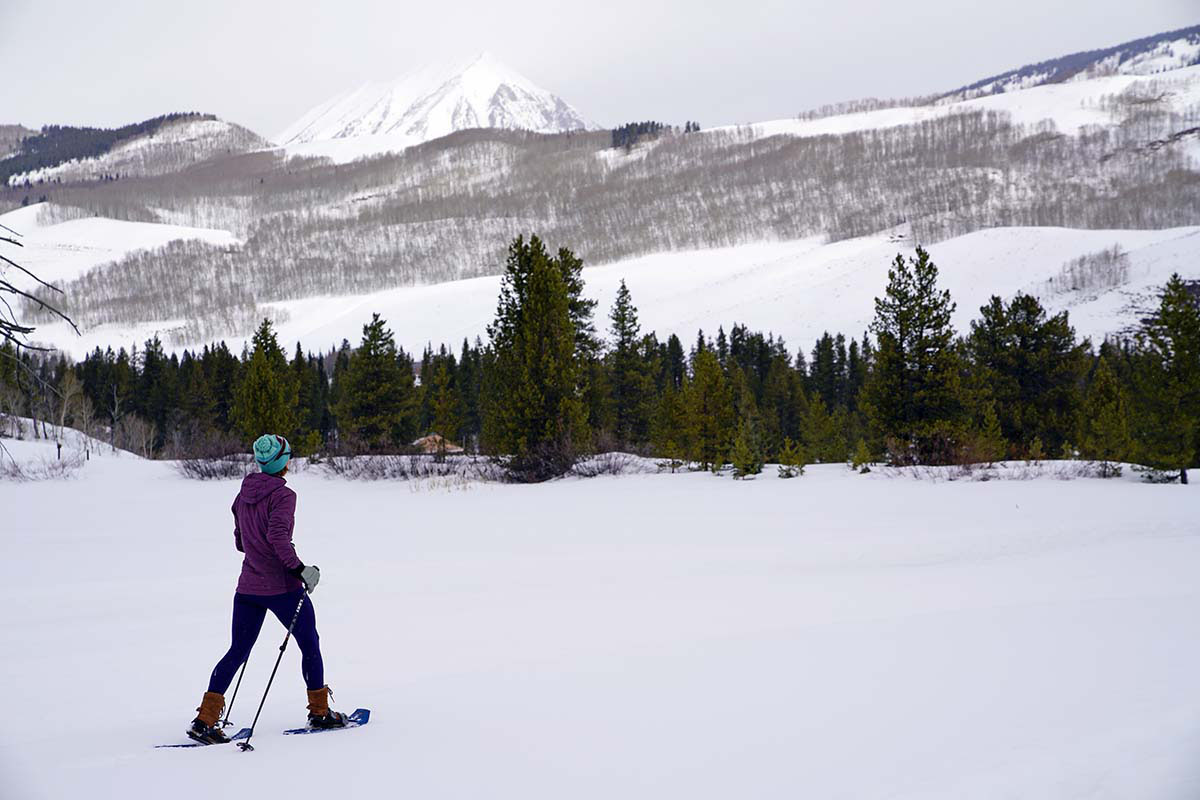
In the world of snowshoes, price often corresponds closely with the quality of the binding. In the case of the $140 MSR Evo Trail, the bindings aren’t deficient in any particular way, but they are undeniably basic. The Evo has a simple three-strap system: two straps run over the top of the foot, while one locks in your heel from the back. In practice, it can take a bit of time to get your foot situated properly in the bindings, and I’ve had issues with them coming undone if not clipped into the proper tensioning hole (it's best to err on a tight fit, especially with the strap around the heel). Plus, you don’t get the “memory”/retention of some higher-end systems that can be set for future use (although we do occasionally leave the heel strap in place to quicken the process).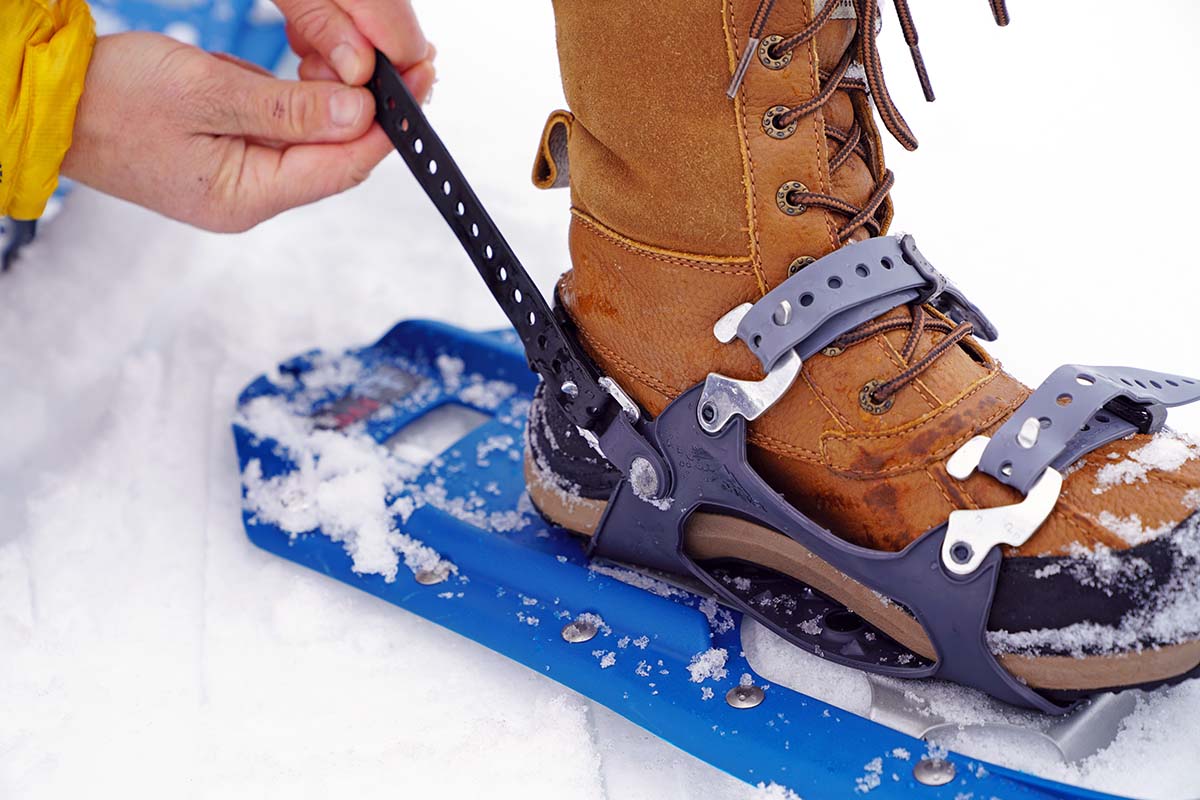
All that said, the Evo Trail’s bindings are clearly well-built: the rubber is strong, and the clips are made of robust steel. In testing multiple variations of the Evo and its predecessor, the Denali, we’ve never had any issues with quality or longevity. And for short excursions, the design is plenty comfortable and easy to get along with. It’s when you start covering serious ground or plan to get out a lot throughout the winter that it makes sense to upgrade to a more advanced binding. MSR offers just that in the higher-end “Paragon” binding system on the Lightning Ascent and Revo Ascent—instead of two straps over the foot, you get what is essentially a mesh basket that provides better hold and comfort. There still are two smaller straps on the side, but you can leave them in place and only have to adjust the heel strap after the first use.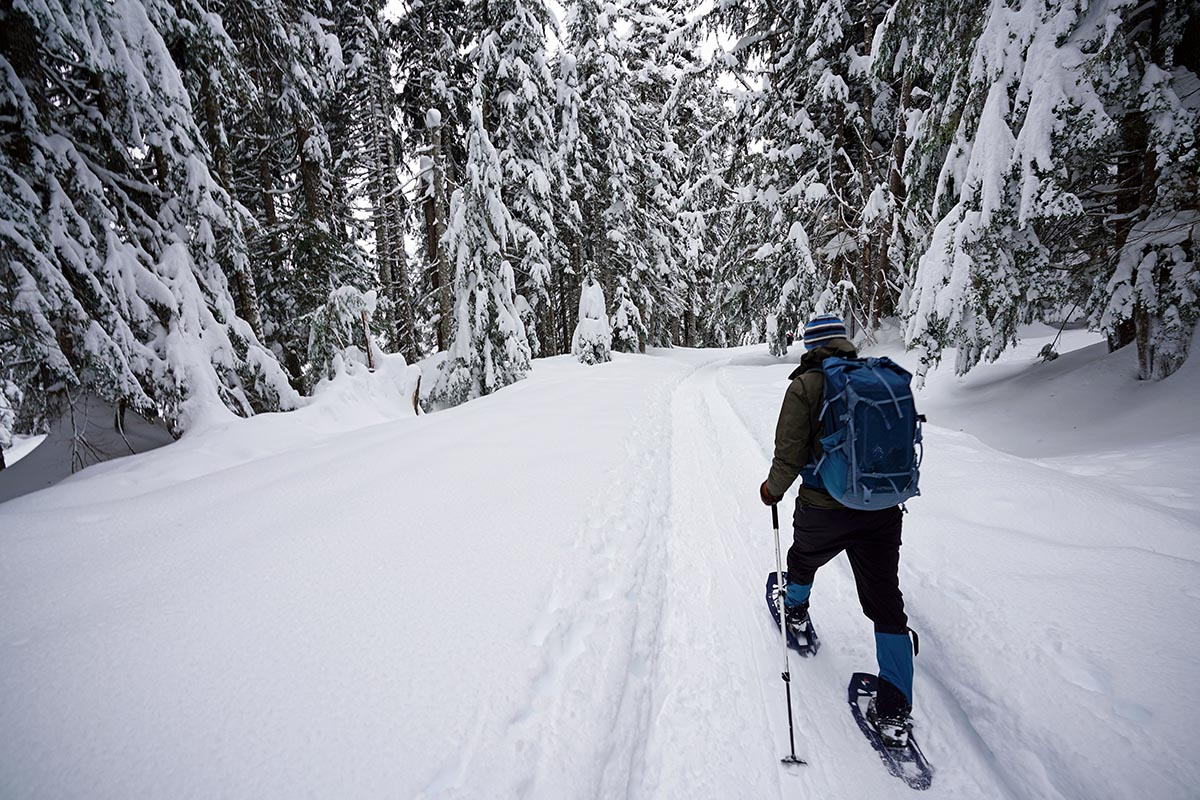
Snowshoes range from around 21 inches all the way up to 36 inches in length, and this number can have a big impact on flotation and load capacity. In this case, the MSR Evo Trail is offered in one length at 22 inches, which is decidedly at the shorter end of the spectrum but in line with its mostly casual intent. As I covered above, the 22-inch length provides good flotation over groomed trails and light to moderate powder. For the deep stuff, you can add MSR’s 6-inch tails for a total length of 28 inches. This still falls well short of the 35-inch MSR Lightning Ascent (with tails) and other deep-snow-oriented models, but in most conditions, the difference in performance was minor.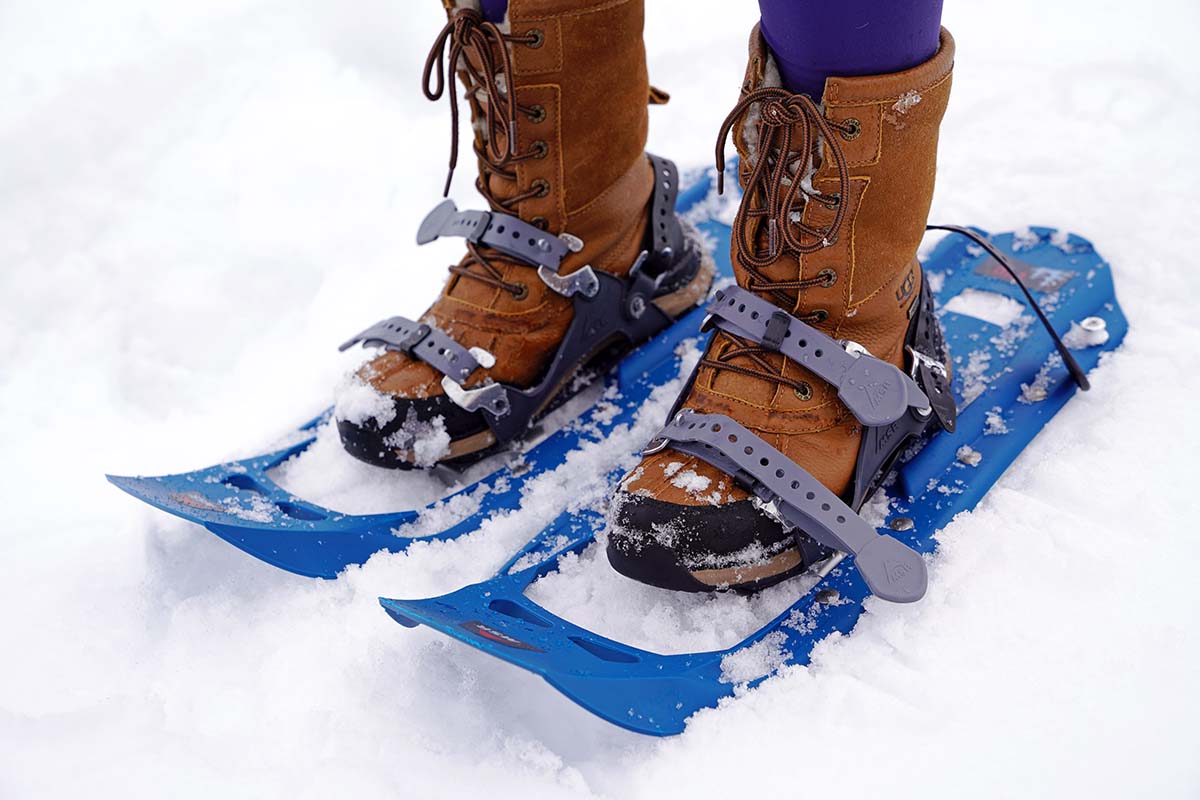
The length of a snowshoe also impacts its recommended load capacity. In the Evo Trail’s case, you get a maximum limit of 180 pounds, which includes the snowshoer plus clothing and gear (like a backpack). In practice, exceeding that number shouldn’t cause any breakage or durability issues, but it will negatively impact floatation. Adding tails to the Evo Trail ups the load limit to 250 pounds, and MSR’s own Revo line has a 220-pound load limit that jumps to 280 pounds with tails (for a price penalty).
At 3 pounds 9 ounces for the pair, the MSR Evo is relatively light and in the same ballpark as other plastic snowshoes. The aforementioned Atlas Helium-Trail checks in a little lighter at 3 pounds 5 ounces, which is likely a result of the cutout gills in the molded plastic design (there’s less material at the back of the snowshoe). The foam Crescent Moon EVA also weighs slightly less than the Evo Trail at 3 pounds 8 ounces, and many of the comparable models with nylon decking are right around 4 pounds.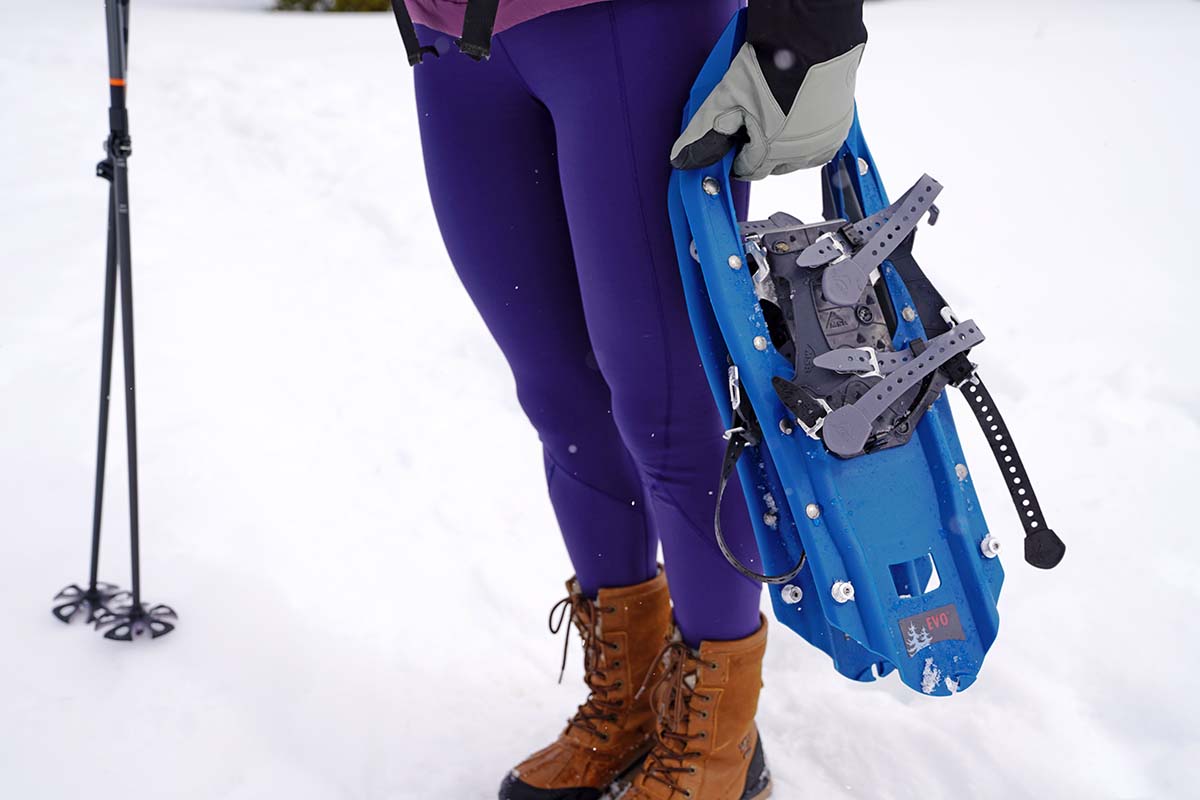
For casual snowshoeing and shorter trips, weight is not a major consideration for us. The truth is that many snowshoes in this category weigh around the same, and most users won’t notice much of a difference (not to mention, you probably aren’t carrying them on your back). Weight and heft start to matter a lot more as you get into backcountry snowshoeing and spending long days on the trail, but at that point, you’ll need the additional floatation and improved traction and bindings of a burlier model anyways. For example, the Tubbs Mountaineer weighs over 5 pounds for the 36-inch version (5 lbs. 5 oz. to be exact), but the added float and improved grip are crucial for more demanding outings and especially deep days.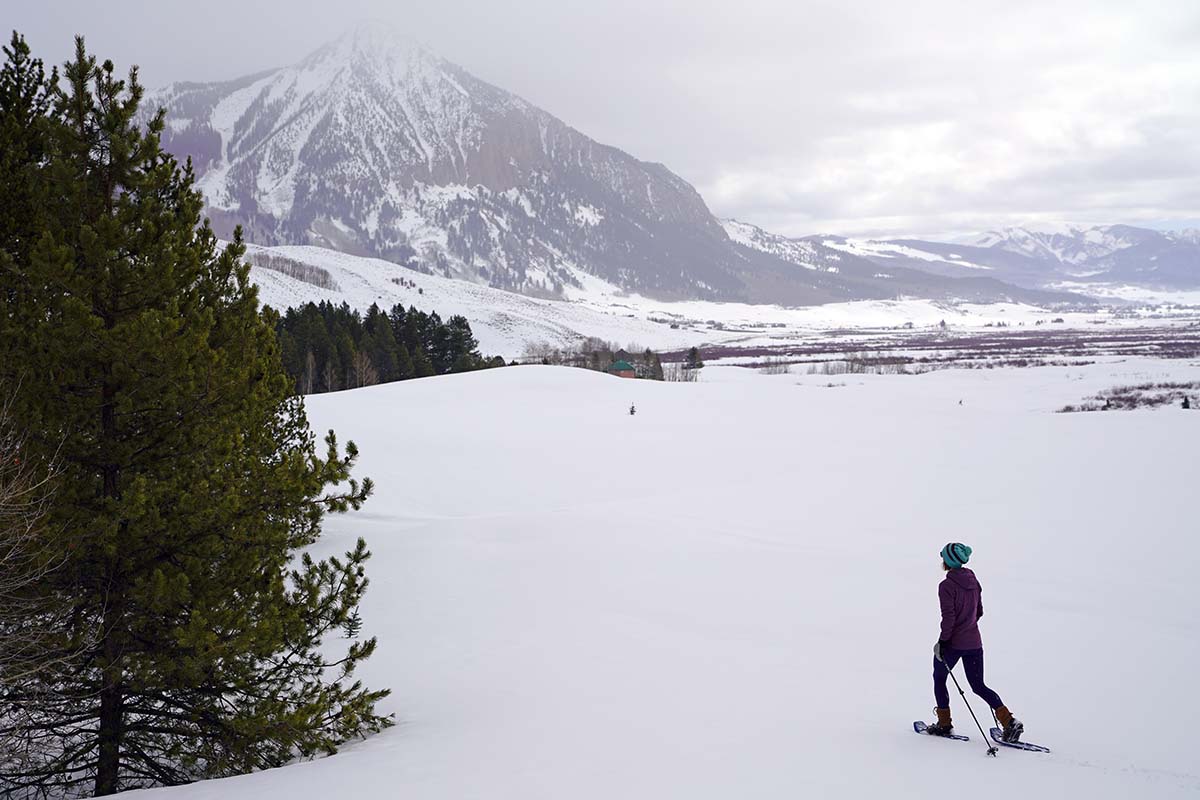
Over many years of testing outdoor gear, we can tell you with confidence that MSR products generally are very well-made and stand the test of time, and the Evo Trail snowshoes are no exception. The plastic decking is thin but durable (we’ve only experienced cracking issues when someone accidentally stepped on our shoes), the steel crampons are burly and impressive for the price, and the buckles are made with quality rubber and steel components.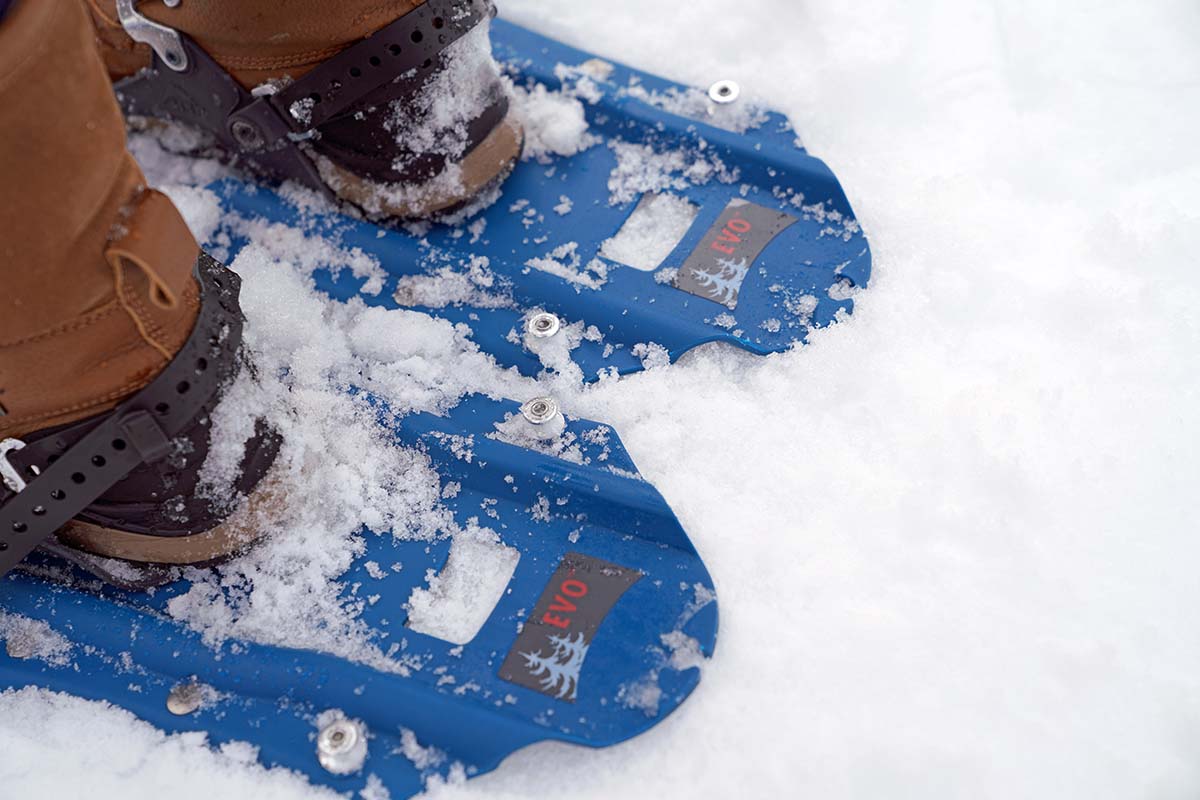
As mentioned above, we did manage to crack an older pair (this was the prior-generation Denali model) when someone stepped on the raised, front lip of our shoes. This is likely due to the hard plastic decking, which feels a bit more brittle and has less “give” than some of the higher-end composite snowshoes. For example, models like the TSL Symbioz Elite ($280) have a noticeably rubbery feel, which translates to bending and flexing under pressure rather than snapping. In the end, however, this isn’t too big a concern. Plastic snowshoes can crack, and nylon shoes can be punctured—remember that snowshoe crampons are somewhat sharp and can generate a good amount of force when weighted—but again, this was a rare occurrence and shouldn't be a major concern if you exercise caution.
In addition to the Evo Trail tested here, MSR also offers the Evo Ascent. Price jumps to $200 with the Ascent, but you get notable upgrades including an added binding strap for extra security on uneven terrain and a more customizable fit, slightly deeper crampons for added bite, and heel lifts for steep sections of trail. Weight goes up to 3 pounds 15 ounces per pair, but the Ascent is a better match for technical terrain. Rounding out the collection, MSR sells both the Trail and Ascent models in kits, which contain all you need to head out on the trail: snowshoes, poles, and a functional storage sack that doubles as a daypack.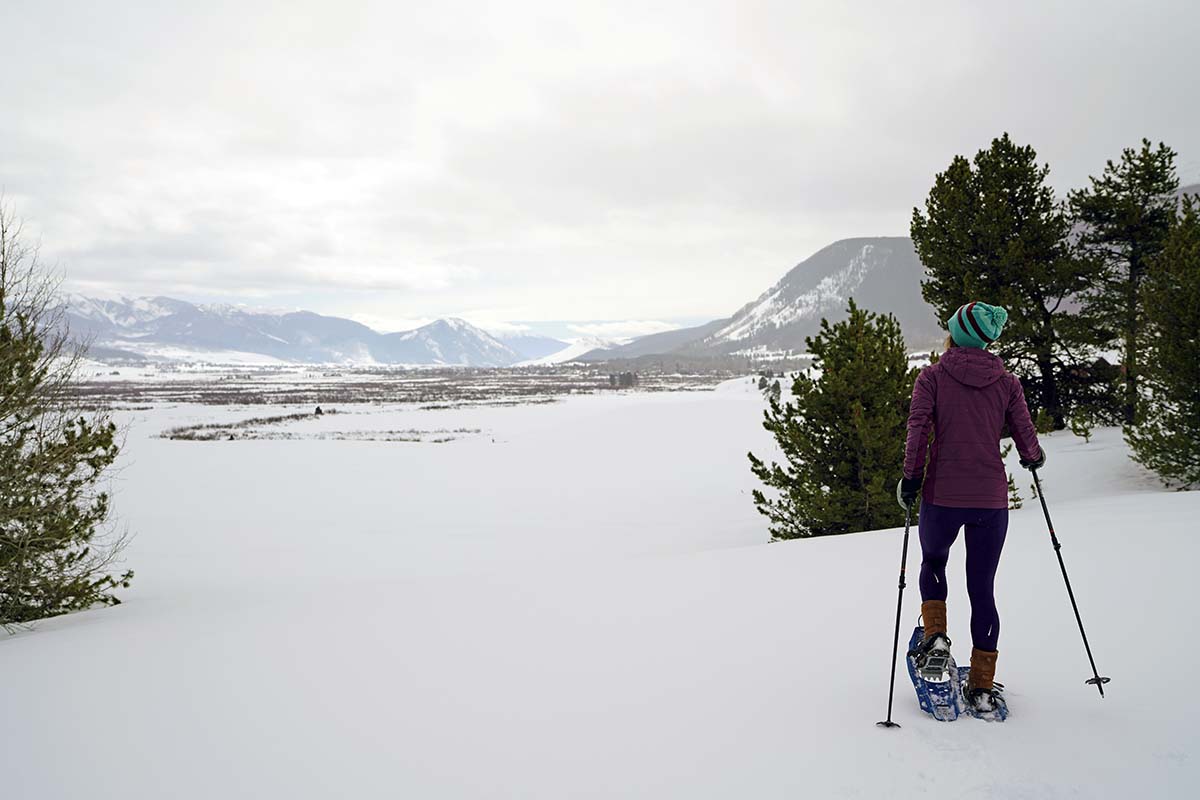
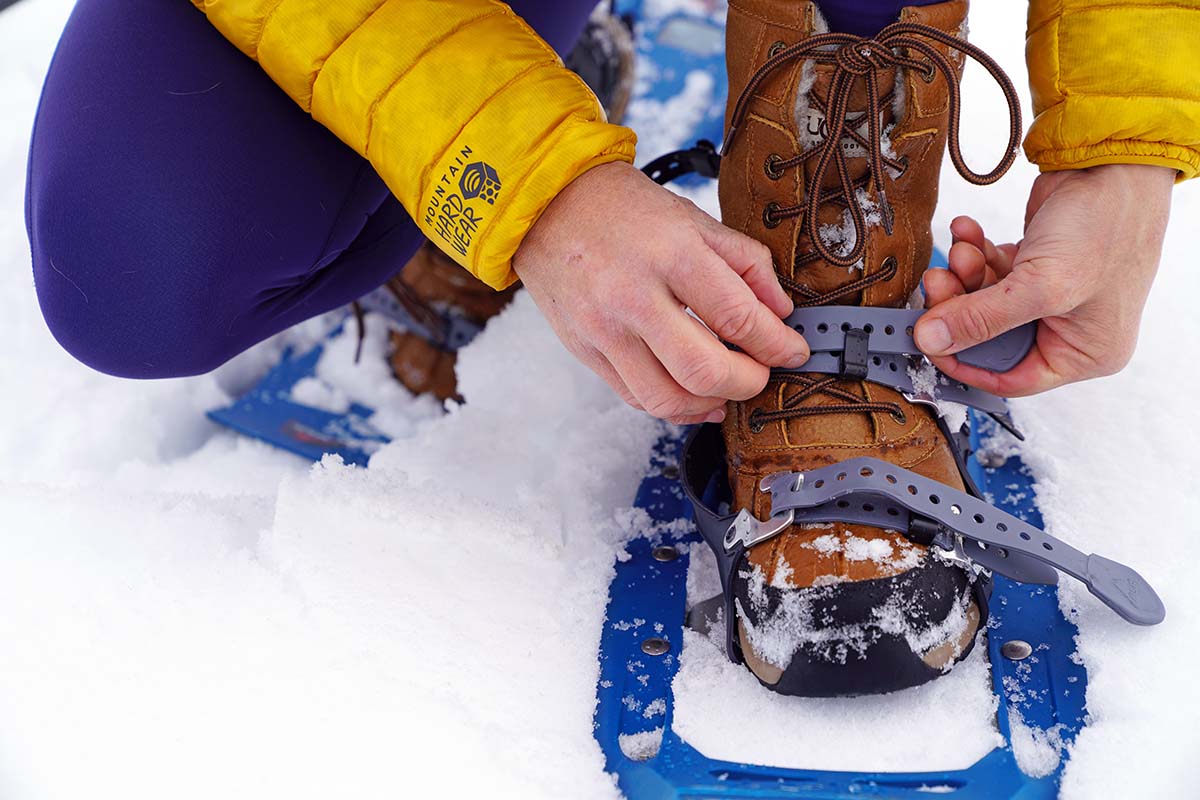
| Snowshoe | Price | Length(s) | Weight | Decking | Crampon | Heel Lift |
|---|---|---|---|---|---|---|
| MSR Evo Trail | $140 | 22 in. | 3 lbs. 9 oz. | Plastic | Steel | No |
| MSR Lightning Ascent | $320 | 22, 25, 30 in. | 4 lbs. 5 oz. | Nylon | Steel | Yes |
| Atlas Helium-Trail | $140 | 23, 26 in. | 3 lbs. 5 oz. | Composite | Steel | Yes |
| MSR Revo Explore | $220 | 22, 25 in. | 3 lbs. 15 oz. | Plastic | Steel | Yes |
| Crescent Moon EVA | $159 | 24 in. | 3 lbs. 8 oz. | Foam | Steel spikes | No |
| Tubbs Xplore | $130 | 25, 30 in. | 3 lbs. 10 oz. | Nylon | Steel | No |
MSR’s Evo Trail is one of our favorite snowshoes for its great all-around performance at a reasonable price point. Another popular model is MSR’s own Lightning Ascent, which offers a number of notable upgrades. For starters, you get a longer length for better floatation in powder (up to 30 in. without tails), premium nylon decking that isn’t as loud as plastic, some of the best traction on the market, and a heel lift for especially steep slopes. And in contrast to the more casual-focused Evo Trail, the Lightning Ascent is built for all types of terrain including steep, icy climbs and backcountry powder, and the Paragon binding is more comfortable. Added up, the Lightning Ascent is our favorite design currently on the market, but it’s more than double the price of the Evo at $320 and overkill for shorter outings and easier conditions. The Evo Trail wins out in value and should be more than enough snowshoe for most users.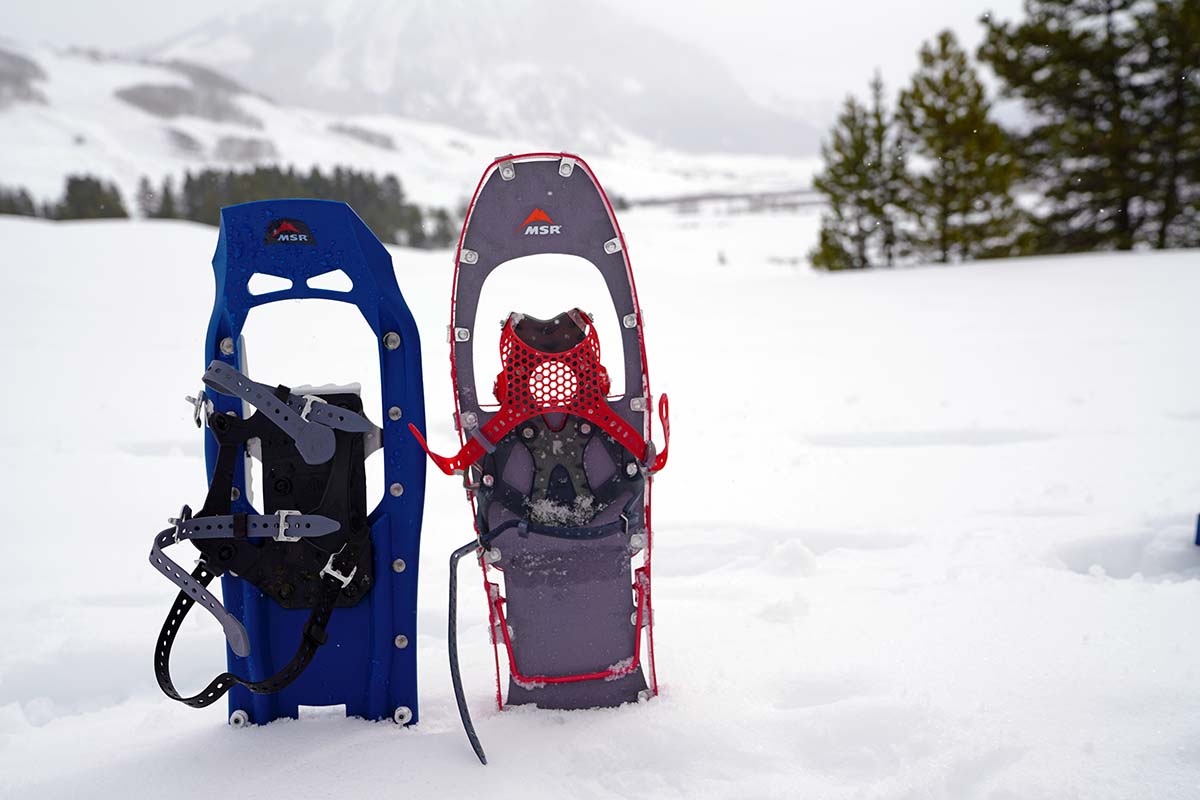
New for winter 2020-2021, the Atlas Helium-Trail is extremely similar to the Evo Trail. To start, both cost $140 and have very similar hard plastic decking, basic binding systems (the Atlas uses connected nylon straps over the foot instead of two rubber straps), and steel crampons running both directions along the bottom of the shoe. In parsing out the differences, the Helium-Trail is offered in 23- and 26-inch versions (but does not have optional tails), whereas the Evo is one size at 22 inches. Weight is similar between the two with the Atlas coming in around 4 ounces less, which is likely due to the “gills” in the decking. And the Helium-Trail comes with a heel lift, which won’t be necessary on moderate terrain but is a nice inclusion for especially steep slopes. In the end, we do have some concerns about floatation given the Helium-Trail’s cutout decking and it's the unproven option, while the MSR has stood the test of time.
Another MSR model to consider is the Revo Explore, which is their middle-of-the-road offering that splits the difference between the Lightning Ascent and Evo Trail. In practice, the Revo does a fairly good job mixing attributes from both designs: the rugged side rails provide reliable grip, and it’s more capable on rolling and challenging terrain but costs a significant $100 less than the Lightning Ascent. That said, there are more well-rounded options in this price range. The Atlas Montane, for example, is $10 more expensive but comes with worthwhile upgrades like flexible decking with superior shock absorption and a more comfortable binding system. Overall, we like the Revo Explore, but the Evo Trail is the much better value.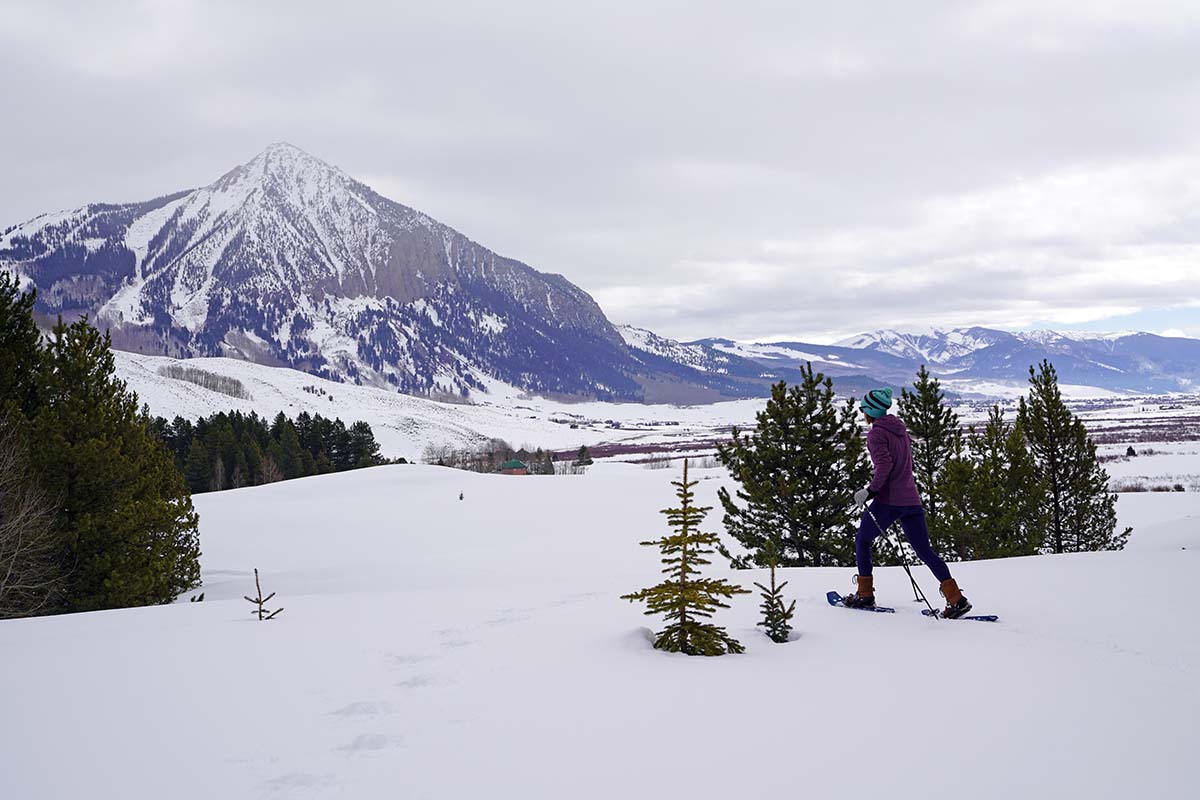
For casual snowshoeing, the Crescent Moon EVA is an interesting alternative to the Evo Trail. Made with foam with steel spikes for traction, this snowshoe certainly is less hardcore than the Evo Trail (and $19 more expensive), but it has its merits. For starters, the Crescent Moon is super easy to put on, not as loud or clunky-feeling as the MSR, and has an additional 2 inches of length for floatation. And importantly, the EVA foam has proven to be surprisingly tough and durable. All things considered, our take is that the EVA is a fun and capable choice for easier terrain and hacking around outside of the cabin. Over icy conditions and more challenging ground, the Evo Trail offers far better traction and stability.
Last but not least is the Xplore, which is Tubbs’ entry-level model and a fine option for casual use. We particularly like the nylon decking, which is quieter and feels softer on the snow than the hard plastic found on the Evo Trail. The Xplore is also made in both 25- and 30-inch variations, which offer better performance in deeper snow than the Evo Trail (sans tails). Where the MSR gets the clear edge is in traction: the Tubbs’ grip is noticeably more limited with one claw-style crampon under the foot. In the end, this is about as cheap as we like to get with snowshoes before the quality and feature set start to decline, but the Tubbs is another affordable and well-made option for those hoping to stay under $150.